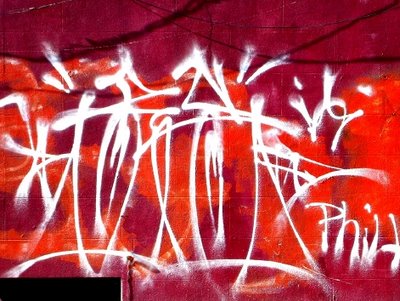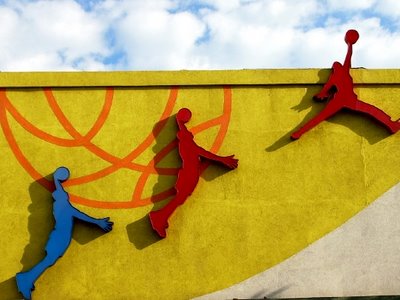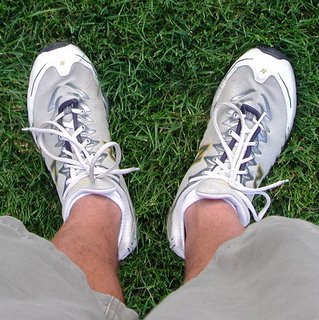The Loneliness of the Long-Distance Runner, Indeed
 Recently, no doubt as a result of my own borough-wide perambulations (you can get a lot of thinking done over a ten-mile run), I've been revisiting the concept of the flâneur. Poet Charles Baudelaire famously descibed the flâneur as a product -- even a hero -- of modernity, an individual with the time and the resources to immerse himself in aimless rambles among the teeming urban masses, an anonymous figure who is both part of the crowd around him and a dispassionate observer. In this way the flâneur is emblematic of the very essence of what it means to be modern, exhibiting all the contradictions of nineteenth century capitalist society and at once capturing the "fleeting and the infinite." As both participant and observer, Baudelaire notes, the Flâneur is simultaneously "shocked and intoxicated" by what he sees around him, repelled and drawn closer at the same time.
Recently, no doubt as a result of my own borough-wide perambulations (you can get a lot of thinking done over a ten-mile run), I've been revisiting the concept of the flâneur. Poet Charles Baudelaire famously descibed the flâneur as a product -- even a hero -- of modernity, an individual with the time and the resources to immerse himself in aimless rambles among the teeming urban masses, an anonymous figure who is both part of the crowd around him and a dispassionate observer. In this way the flâneur is emblematic of the very essence of what it means to be modern, exhibiting all the contradictions of nineteenth century capitalist society and at once capturing the "fleeting and the infinite." As both participant and observer, Baudelaire notes, the Flâneur is simultaneously "shocked and intoxicated" by what he sees around him, repelled and drawn closer at the same time.In the twentieth century, the idea of the flâneur was further examined by literary critic Walter Benjamin. While Baudelaire saw the flâneur as part of the crowd around him (it is his "element," the poet wrote, "as the air is that of birds and water of fishes"), Benjamin emphasized his alienation from the masses, suggesting that the "heroism" of the flâneur was a direct result of his distance from the crowd, not his integration into it. Regardless, as both involved protagonist and detached commentator, the flâneur was able to "read" the city as a text while serving as one himself, an intermediary who interpreted the sights and activities of the urban landscape for others even as he made his way across it.
Benjamin (who, by the way, is pictured above), also joined Baudelaire in pointing out the significance of some of the physical manifestations of modern capitalism, believing that the storefronts, signs, advertisments, and even men walking up and down the street in sandwich boards all offered insight into the modern condition for the flâneur, providing intellectual satisfaction and simple entertainment at the same time.
So what am I getting at here? Good question. I guess it's just that I sometimes wonder whether I, in my criss-crossing of Brooklyn, am not a sort of 21st century flâneur in running shoes. The similarities are intriguing: I have the leisure time to engage in such an enterprise (as opposed to, say, working 12 hours a day in a factory); I am constantly surrounded by people but very rarely actually interact with them; I use the things I see and learn to sate my own curiosity and my photographs to entertain (for lack of a better word) myself and others; my experiences are "real" on one level (in that I am indeed physically on the sidewalk) while lacking in a certain "authenticity" on another since I am not (and cannot be) an integral part of the tableaux I pass. Of course, this whole thing could lead to deeper consideration of just what "authentic" means in the first place (is a graffito made by a hipster in Williamsburg, for example, less "authentic" than one made by a gang member in Brownsville?), but I'll save that discussion for another day.
For now, I'll just offer all of this up as food for thought, a minor meditation on the ambivalence I sometimes feel about this whole running-all-of-
Brooklyn thing, about the nature of experience, and about my simultaneous roles as outsider and intimate within the diverse neighborhoods of my adopted city. The simple truth is that over the next year or two I'll run by the residences of over two and a half million people, but there are times while I'm out there that I've never felt more alone, or less a part of anything. Weird.
I'll be back running (and, most likely, thinking too much) tomorrow. Today, though, here are a couple of recent pictures:

Bed-Stuy

Brownsville (Pitkin Avenue)


3 Comments:
What do you make of Susan Sontag: "Do stuff. Be clenched, curious. Not waiting for inspiration's shove or society's kiss on your forehead. Pay attention. It's all about paying attention. Attention is vitality. It connects you with others. It makes you eager. Stay eager." (I think she said this in response to the alienation trend in 20th c. literature)
I'm currently writing on the history of running as cultural ritual in the Americas and this made me think: What about running as modern ritual, both private and public?
(Ah, the cultural studies papers waiting to be written.)
I think there's a lot that could be done, academically, about running. Certainly cultural studies stuff, but also history and psychology and sociology... But it does seem an especially modern thing. Sure, there were footraces going back thousands of years and competitive events like that, but I've got to imagine that running as a leisure activity (as with most leisure activities) is a relatively recent phenomenon.
Post a Comment
<< Home